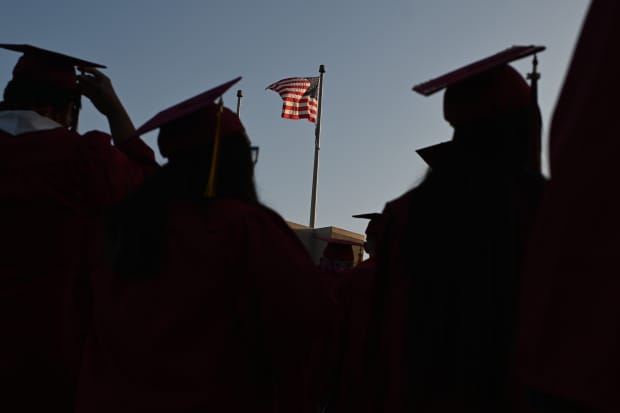These risky loan products can have interest rates as high as 35%, according to a report by the Student Borrower Protection Center.
USURY BY ANY OTHER NAME
Published: July 20, 2020 By Jillian Berman

A new report highlights the $5 billion 'shadow' student debt market. (Photo by Robyn Beck / AFP)
Roughly 44 million Americans are coping with $1.6 trillion in student-loans, but that staggering figure likely underestimates the debt borrowers are taking on to finance their education, a new report suggests.
Over the past decade, students have borrowed more than $5 billion through an opaque web of companies to pay for training at for-profit schools, the Student Borrower Protection Center, an advocacy group, found. These products, which aren’t traditional federal or private student loans, often carry high interest rates and other risks for borrowers, according to the SBPC.
In addition, by providing financing to students, this shadow credit system, as the SBPC dubs it, helps to keep programs training students for careers in fields like trucking and cosmetology in business — even when they’re prohibitively expensive for many and don’t provide graduates with a credential that’s valuable in the labor market.
“This whole cottage industry is allowed to prey on and rip off the most vulnerable borrowers in our country,” said Seth Frotman, the executive director of the Student Borrower Protection Center. “These players are key cogs in the larger student-debt crisis, but also critical components of what allows predatory schools to thrive.”
The ‘shadow credit system’ has grown since the Great Recession
Though typically out of the public and regulatory eye, these products have taken on a more prominent role in the student finance landscape since the Great Recession, according to the SBPC’s report. In the past, for-profit colleges relied on traditional, private lenders to provide loans to students, which were bundled together and sold to investors. Often these loans were made to students with little regard for whether they would be able to repay them.
In the years since the financial crisis, traditional, private lenders have dramatically reduced their involvement in the student-loan market broadly. These so-called shadow lenders stepped in to fill the void for students financing career training at for-profit colleges, according to the report.
These companies work with schools in three key ways, the report found. The first is as an exclusive partner for students needing financing. In some cases that can mean developing a product for a specific program or helping a school lend to its students. The second is by offering an independent credit product that in some cases schools will promote through their website or financial aid materials.
The third is servicing or collecting on debt students owe to schools for tuition. In these cases, students will enroll in a course without paying anything up front, but wind up owing this money with interest. Some of the companies highlighted in the SBPC report work with schools to service and collect this debt, they found.
Steve Gunderson, the chief executive officer of Career Education Colleges & Universities, a trade group representing for-profit colleges, took issue with the report and, in particular, its 10-year scope. He said that by including the practices of large schools that have since shut down, such as Corinthian Colleges and ITT Technical Institute, the report “tries to find sins of the past and use them to define and describe the sector today.”
“A multi-generation, family-owned school in a community is going to do whatever they can to help the students,” he said. If the easiest option is to loan money directly to students, “they’re going to do it with the best of intentions even if they don’t have what you and I call the best of procedures.”
Interest rates as high as 35%
The products highlighted by SBPC are offered by at least 12 distinct companies and carry a variety of risks for borrowers, the report found. In some cases, interest rates are as high as 35%. In others, they carry fees that aren’t typical of federal and private student loan products.
But they’re not just costly; these products put borrowers at risk in other ways. One lender, TFC Tuition Financing, advertises to nursing schools interested in its loan program that a borrower’s certification can be taken away in the event of default, the report found. TFC did not immediately respond to a request for comment on the report.
In addition, some products require that borrowers be rejected by another lender before being approved; others advertise that they can provide financing without a credit check or underwriting.
Meanwhile for the colleges, the products allow a means to sidestep regulation, the report found. For schools that rely on federal financial aid, these products can help them comply with the 90/10 regulation, a rule that requires colleges receiving federal financial aid to get at least 10% of their funds from a source other than the government’s student loan program. By working with these opaque lenders, schools can create their own lending programs that students can use to finance tuition, which don’t count toward the 90% limit on federal financial aid financing.
For programs that aren’t accredited, and therefore can’t participate in the federal student loan program, these products provide a source of financing for students who wouldn’t otherwise be able to afford the programs and a source of revenue for the schools.
The report urges governments at various levels to take a closer look at these companies, including by requiring them to register with state regulators and by creating a federal registry of all nonbank financial services firms, including those highlighted in the report.

No comments:
Post a Comment